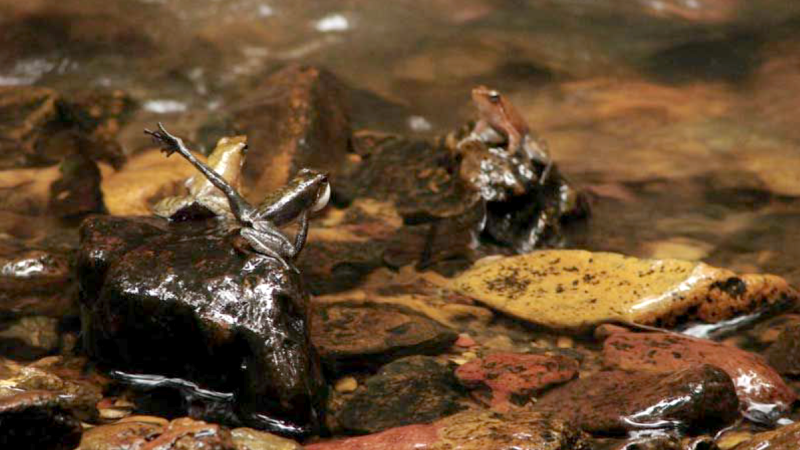
Image Credits: KV Gururaja
In the animal world, finding a mate, protecting territory and fending off competitors who vie for love are defining moments. Only those adept at the needed skills for these ‘do-or-die’ circumstances survive, reproduce and thrive. A few animals go the extra mile—sing a romantic song, flash their colours to scare competitors and also woo their mate, some chirp high loud to stand out in the crowd and some, like the dancing frogs, shake a leg!
The dancing frogs, also called torrent frogs, belong to the genus Micrixalus. Endemic to the Western Ghats of India, these tiny frogs, measuring just about three centimetres, are found around the numerous streams. Their oomph is on full display during the breeding season that lasts from September to November, just after the monsoon. The males bring out their best moves to fend off other competing males to attract the female. With their white vocal sac bulged, the males tap and wave their feet in the air and kick the hind legs! This crafty dance, while in some species, attracts the females, keeps competing males in check in others. Our understanding of the intricacies involved in the ‘dance’ and its exact purpose is still evolving.
The mating ritual of the dancing frogs is also quite interesting. Once a female falls for a male, she approaches him and lets him mount on her. The pair slides into the water, where he fertilises her eggs. She quickly digs up some sand and gravel with her hind legs and lays her eggs inside, conceals it further from the watchful eyes of predators and hopes for the best!
So far, scientists have recorded 24 species of the dancing frogs from the Western Ghats, with 14 of them discovered as recently as 2014. Emerging technologies in DNA analysis hold hopes of discovering many more new species in the coming years. However, herpetologists are hoping that until then, the pristine evergreen forests of the Western Ghats would stay intact. Today, the habitats of these frogs are fast-changing due to expanding agriculture and infrastructure developments, and the future of endemic species like the dancing frogs is very precarious. Hopefully, they can ‘shake off’ this looming threat!
This article was first published in Deccan Herald.





